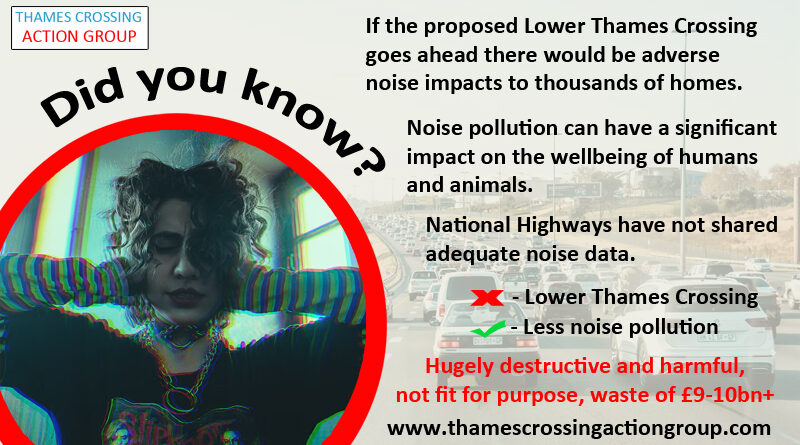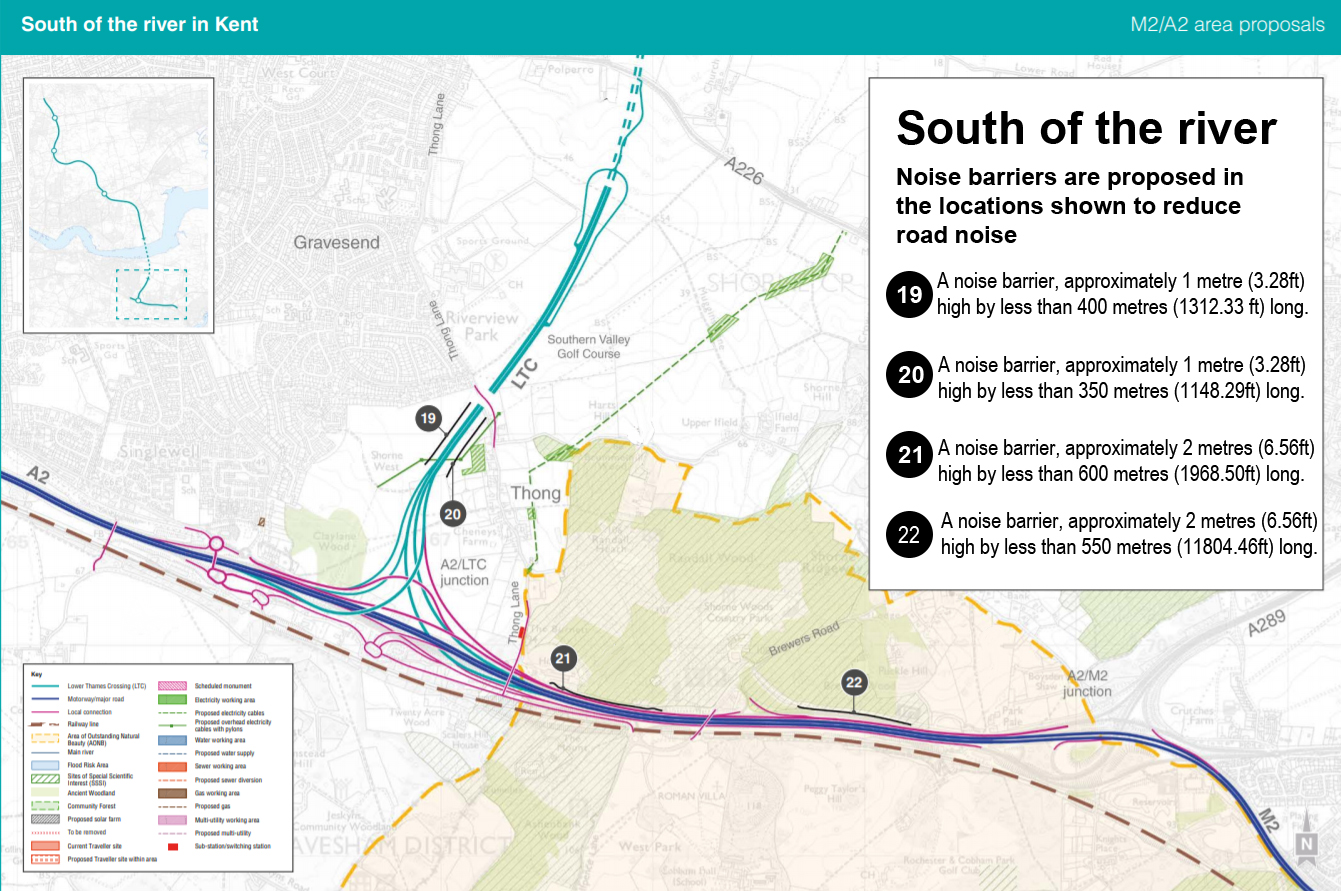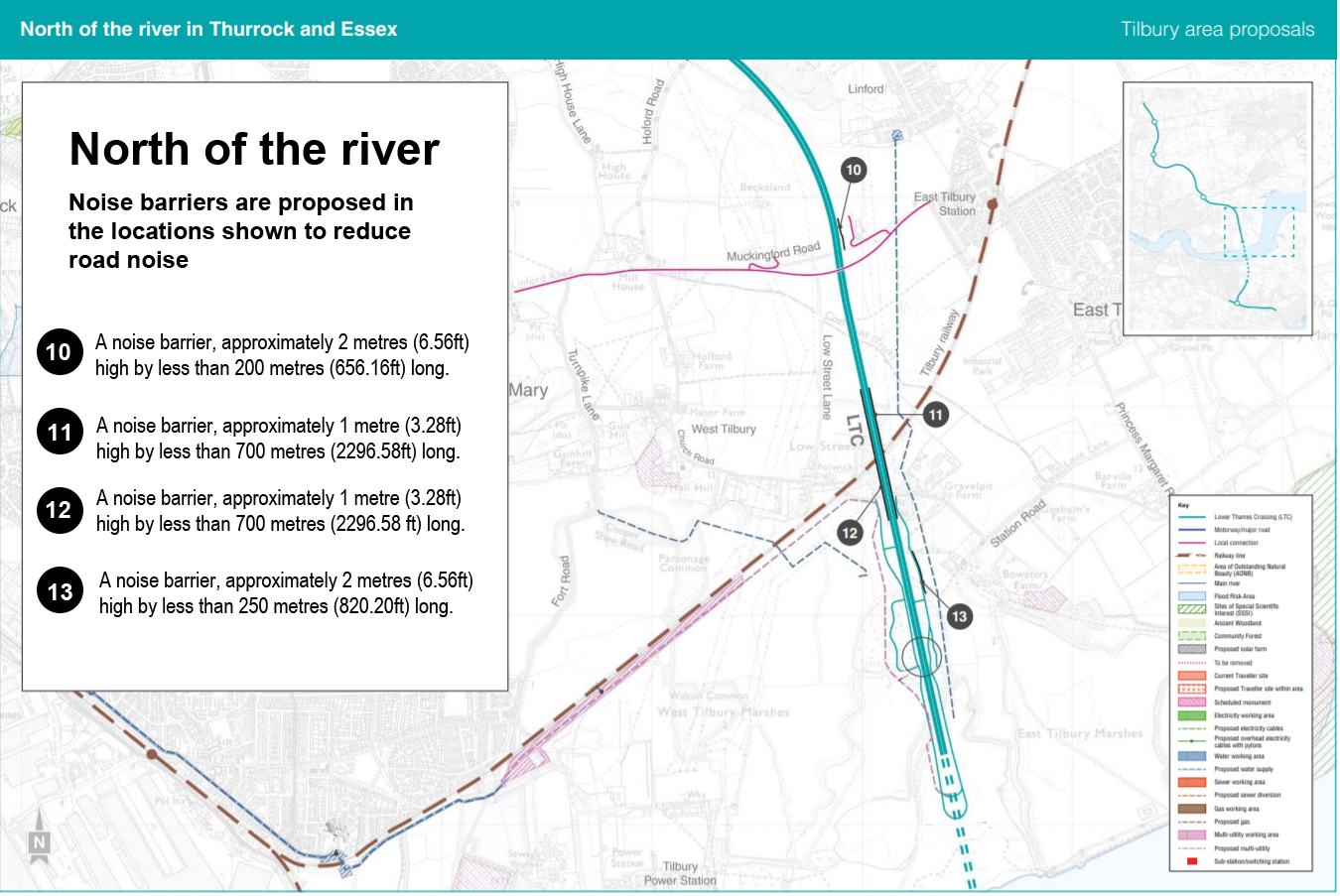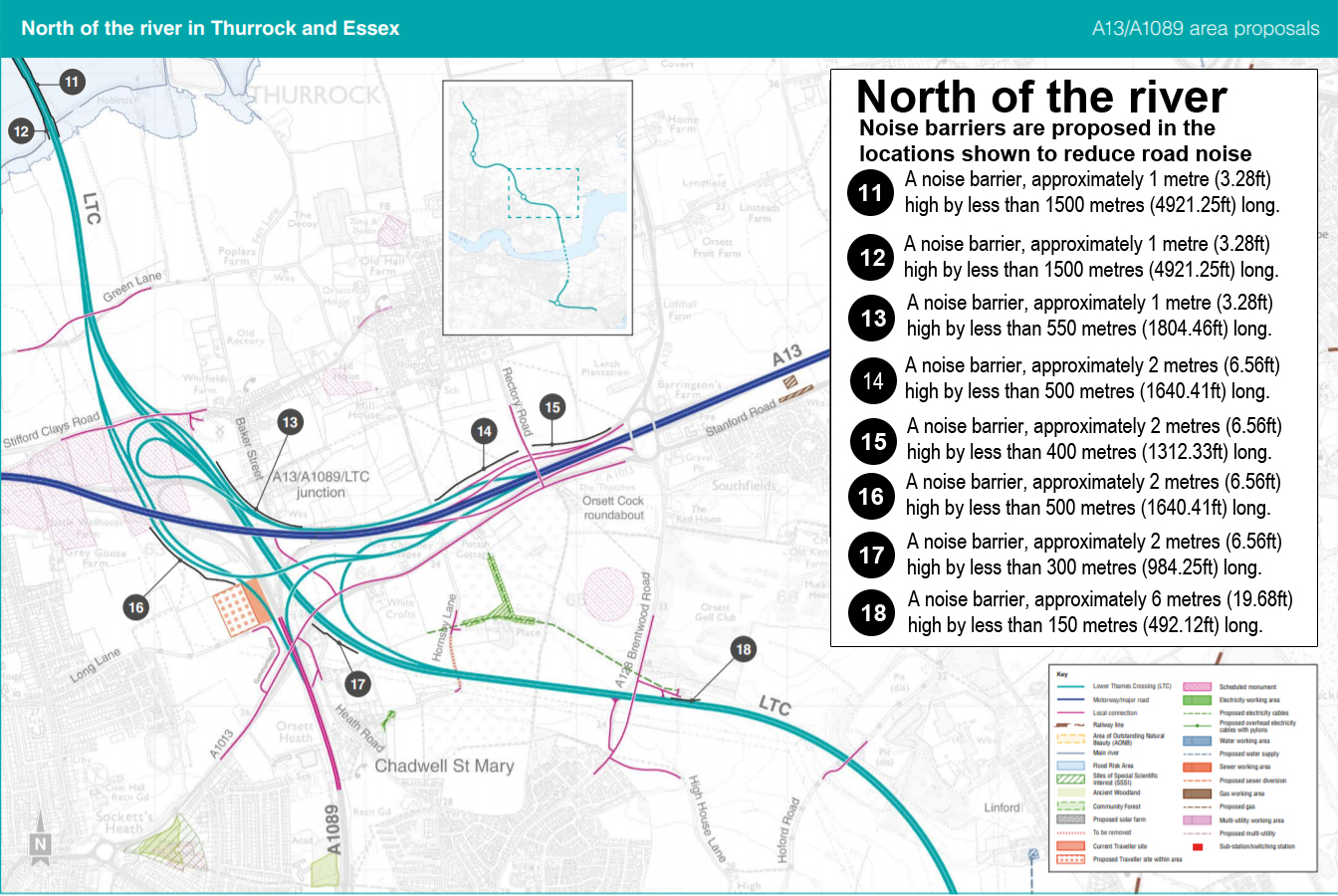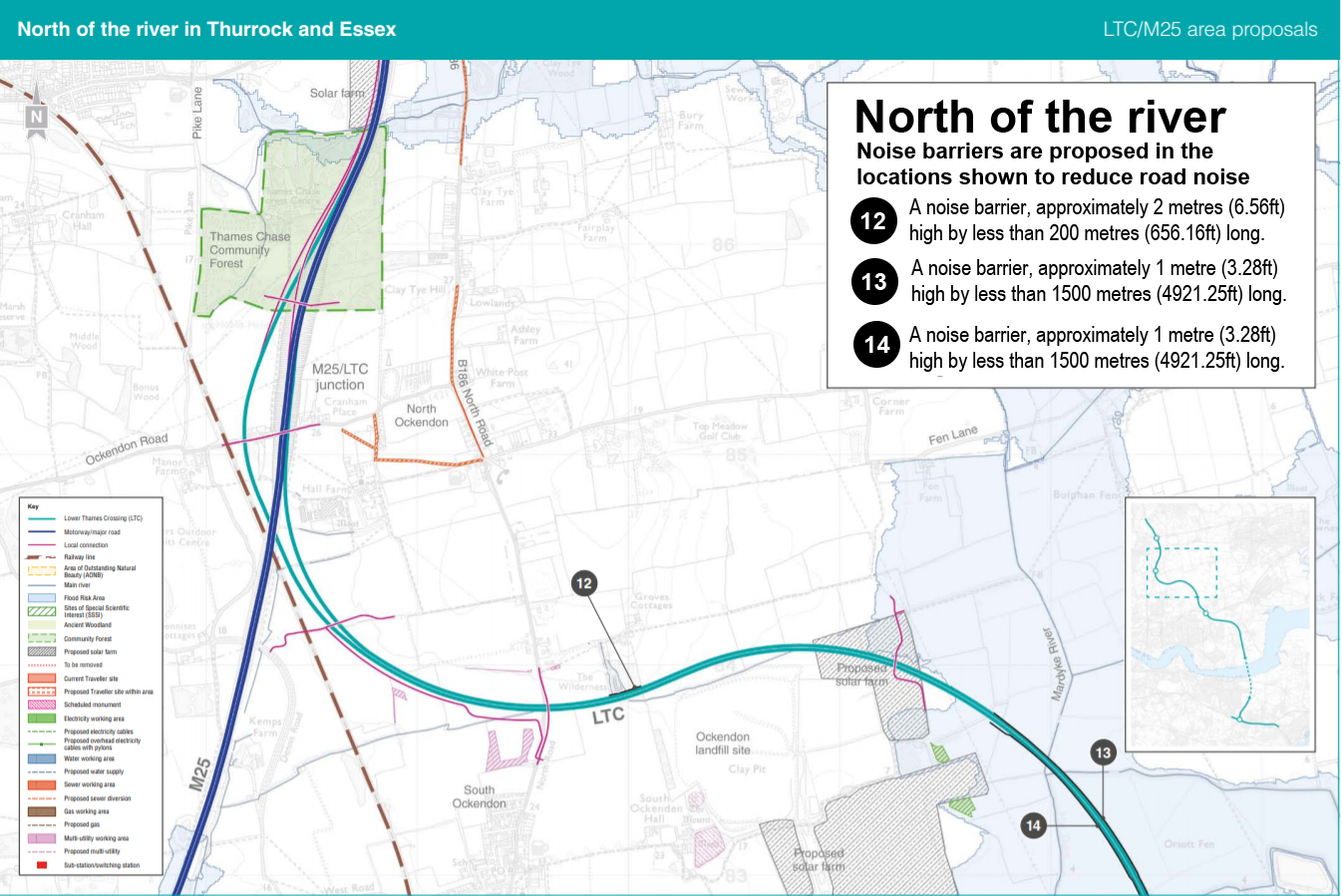LTC Noise Pollution
Noise pollution can have significant impacts on the health and wellbeing of humans and animals. It doesn’t just come from the engine noise of vehicles either, it can also come from things like road noise as tyres drive over the surface. One of the refinements in the Design Refinement Consultation was the addition of 17 LTC Noise Barriers.
National Highways have stated in the Design Refinement Consultation guide that following the Preliminary Environmental Information Report (links in ‘Related Reading’ section below) which was published in 2018 Statutory Consultation, which identified the need for noise mitigation, further detailed noise assessments have been carried out. These assessments have identified locations along the proposed route where noise barriers could be used to reduce road traffic noise.
So where are these noise barriers located?
Please be aware that the maps below are taken from the consultation guide, but we have photoshopped out some additional points to try and make it easier to highlight just the Noise Barrier aspect in these maps.
South of the river (Kent) (pages 28 and 29 in the guide to Design Refinement Consultation)
The design proposes four noise barriers, up to 600 metres (1968.50ft) long and between 1 and 2 meters (3.28ft and 6.56ft) high. These would, according to HE, help to mitigate potential road traffic noise effects in the local areas, including Gravesend, Shorne and Thong. Also according to the Environmental Impacts Update (EIU) “Although they introduce a new built element and may introduce new visual receptors, there would be no change in the nature of effects or mitigation measures reported in the PEIR.” (Taken from page 200 – Environmental Impacts Update July 2020)
North of the river (Thurrock) (pages 44 and 45 in the guide to Design Refinement Consultation)
Four noise barriers, up to 700 metres (2296.58ft) long and between 1 and 2 metres (3.28 and 6.56ft) high, are proposed in the Tilbury area between the northern tunnel entrance and Muckingford Road, NH state that these would help to mitigate potential road traffic noise effects in the local area, including East Tilbury, West Tilbury and Chadwell St Mary. Again according to the EIU “Although they introduce a new built element and may introduce new visual receptors, there would be no change in the nature of effects or mitigation measures reported in the PEIR.” (Taken from page 200 – Environmental Impacts Update July 2020)
(pages 58 and 59 in the guide to Design Refinement Consultation)
A noise barrier, less than 150 metres (492.12ft) long and six metres (19.68ft) high, is proposed near Brentwood Rd. According to NH this would help to mitigate potential road traffic noise effects in the local area, including Chadwell St Mary.
Five noise barriers, up to 550 metres (1804.46ft) long and between one and two metres (3.28 and 6.56ft) high, are proposed in the A13/A1089 area. According to NH this would help to mitigate potential road traffic noise effects in the local area including Chadwell St Mary, Orsett and Orsett Heath.
Again according to the EIU “Although they introduce a new built element and may introduce new visual receptors, there would be no change in the nature of effects or mitigation measures reported in the PEIR.” (Taken from pages 200 and 201 – Environmental Impacts Update July 2020)
(pages 72 and 73 in the guide to Design Refinement Consultation)
Three noise barriers are proposed in the LTC/M25 area. Two are up to 1,5000 metres (4921.25ft) long, and both are approx one metre (3.28ft) high. One is less than 200 metres (656.16ft) long and approx two metres (6.56ft) high. According to NH these barriers help to mitigate the road traffic noise effects in the local area, including South Ockendon.
Again according to the EIU “Although they introduce a new built element and may introduce new visual receptors, there would be no change in the nature of effects or mitigation measures reported in the PEIR.” (Taken from page 201 – Environmental Impacts Update July 2020)
Points to bear in mind
Let’s start with the fact that whilst NH state in the Design Refinement Consultation materials that they are adding 17 noise barriers, if you count the ones they show in maps, as we’ve highlighted above, there are actually 19 noise barriers. We have checked with NH and been told that two of the proposed noise barriers on pages 58/59 labelled as numbers 11 and 12 (top left of the map) are actually the same proposed noise barriers that are shown on pages 72/73 labelled as numbers 13 and 14 (bottom right of the map). Because of the way the maps are presented this is not obvious, and had to be explained by NH.
Also there is very little commitment in the dimensions of the noise barriers. There are no cross sections or elevational drawings. If for example you say that a barrier is less than 1500 meters doesn’t that mean that in reality it could be as short as say 1m or as long as 1499 metres?
NH have not announced exactly what these noise barriers will be made of or look like. Evidently it is highly unlikely that this kind of detail will be shared before at least Development Consent Order (DCO) stage. But that shouldn’t stop us asking and giving our opinions on what we think is needed! We need to stress that this makes it difficult to make any meaningful representations in the consultations as we do not have adequate info.
NH have not provided us with data that shows how these locations for the noise barriers have been decided upon. There is very little info or data about noise in the environmental update, which again you might want to stress means it makes it difficult to make any meaningful representations. We will let you know if we manage to get hold of any of this kind of data/evidence.
Bear in mind that certain things relating to LTC will likely be the subject of a requirement on the DCO which will be discharged after the DCO is granted. It could be that the Department for Transport discharge the requirements, or we could comment in our consultation responses that we feel our Local Authorities would be better placed to discharge these requirements, since they know our area better than the DfT.
It is important that we all comment in our responses that we have concerns about the material, height, and effectiveness of the barrier, and state that we would like to be consulted on the design at the relevant time.
At the NH webinar on Tues 21st July 2020, in response to a question about the 6m barrier near Brentwood Rd attendees were told the barrier is for one specific property not the golf course or Chadwell St Mary in general. The fact the barrier is also on the opposite side of the LTC to Chadwell St Mary as far as we can see means it would not benefit residents in the main part of Chadwell St Mary at all anyway.
Whitecroft Care Home is surrounded by LTC and LTC slip roads and there are no noise barriers protecting them at all.
In the Oct 2020 LTC Appraisal Summary Table it is stated that thousands of households would suffer with increased noise both in the daytime and at night.
Consider the height of an average HGV and ask yourself if you feel that a 1 or 2 metre noise barrier is adequate?! Do you feel the locations and dimensions of the proposed noise barriers are sufficient?
TCAGs opinion in short
We do not feel we have been provided with anywhere near enough data and info to adequately be able to give an opinion of the noise barrier aspect of LTC. From the little info that has been provided we have serious concerns that they are not adequate or that the locations chosen alone will be adequate for the needs of all communities along the route.
It appears that National Highways have not even completed their noise (or air) pollution assessments at the time of the Local Refinement Consultation. They have therefore not shared this important info with the public in regard to the latest changes. How they expect us to respond without such important details is beyond us.
Related reading
Here’s a list of links to the PIER documents from the 2018 Statutory Consultation for further reading.
- Preliminary Environmental Information Summary4.1 MB (PDF document)
- Preliminary Environmental Information Report6.3 MB (PDF document)
- Preliminary Environmental Information Report – Appendices16.7 MB (PDF document)
- Preliminary Environmental Information Report Figures – Chapter 2 Project Description33.1 MB (PDF document)
- Preliminary Environmental Information Report Figures – Chapter 6 Air Quality28.7 MB (PDF document)
- Preliminary Environmental Information Report Figures – Chapter 7 Cultural Heritage51.6 MB (PDF document)
- Preliminary Environmental Information Report Figures – Chapter 8 Landscape55.8 MB (PDF document)
- Preliminary Environmental Information Report Figures – Chapter 9 Terrestrial Biodiversity6.5 MB (PDF document)
- Preliminary Environmental Information Report Figures – Chapter 11 Geology and Soils71.5 MB (PDF document)
- Preliminary Environmental Information Report Figures – Chapter 12 Materials2.7 MB (PDF document)
- Preliminary Environmental Information Report Figures – Chapter 10 Marine Biodiversity1.4 MB (PDF document)
- Preliminary Environmental Information Report Figures – Chapter 13 Noise and Vibration28.7 MB (PDF document)
- Preliminary Environmental Information Report Figures – Chapter 14 People and Communities36.6 MB (PDF document)
- Preliminary Environmental Information Report Figures – Chapter 15 Road Drainage and Water Environment43.9 MB (PDF document)

